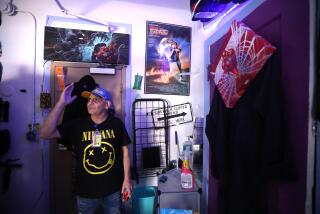Nakamichi Group Puts Money Where There’s Music
- Share via
In days when many foundations are turning increasingly to matching grants, providing services and getting involved in production decisions, the folks at the E. Nakamichi Foundation do philanthropy the old-fashioned way: They give money away.
“There’s tremendous pressure on us, as other sources of funding are weakening or drying up,” reports Les Mitchnick, executive director of the foundation. “Each board meeting, we’ve been forced to consider more applications in both numbers and dollars.”
The foundation was established in 1982 with a $20-million bequest from the late Etsuro Nakamichi, a Japanese industrialist. The money came from his personal assets, and the foundation does not receive any financial support from the Nakamichi Corp., a Japanese consumer electronics giant.
The foundation did not receive the funds until 1985, however, and began giving grants in October of that year. In its brief existence, the foundation has awarded nearly $4 million, while pushing its endowment to $26 million through investments.
Although the foundation does require a final accounting, there are few other strings on its money. Grants are outright, the foundation never gets involved in production and performance decisions, and there are even no special application forms or guidelines.
“I want to read all the proposals,” Mitchnick, 46, says. “I’ve carried a lot of my grant-making views out of my fund-raising past.”
That and the fact that he heads a staff of two have much to do with the informality of the foundation operation, and its uncommon consideration for its applicants.
“Everyone is notified (about whether their proposal has been accepted) within 48 hours of the board meeting. I just pick up the phone and call them.”
The friendliness of the process, the lack of constraints on the Nakamichi largess, and the constriction of public arts funding have brought the foundation as much business as it can handle and more. Initial board meetings considered $10 in applications for every $1 that could be awarded; now the figure has climbed to $16 in requests for every dollar that goes out.
“I think the first thing we look at is the quality and the performing reputation of the applicant--what have they done in the past, are they capable of carrying out what they plan? Then we ask how many people will benefit from it.”
Many of the people who have benefited from Nakamichi-funded programs live in California, and the Los Angeles area in particular, though that has not been intentional on the foundation’s part.
“It’s just worked out that we give about 50% within California and 50% in the rest of the country,” Mitchnick says. “We don’t have any geographic limits within the country.”
Though Mitchnick says that the foundation awards grants only for one year, with no promise to renew, it has consistently supported significant local projects in these early years.
The Da Camera Society, for example, received $11,148 from the foundation in 1987, $66,000 in 1988, and $86,750 is slated for 1989 (the Nakamichi fiscal year is the calendar year, thus some of its grants listed in two years actually support a single concert series or program, spanning the calendar change).
The Da Camera Society’s Chamber Music in Historic Sites season begins today, with the Fine Arts Quartet in the first of the Doheny Soirees, while the Franz Liszt Chamber Orchestra launches the Nakamichi Brillante series Oct. 16. According to MaryAnn Bonino, director of the society, the awards from the foundation have enabled her organization to book more expensive ensembles for the Brillante series, without raising prices.
The Nakamichi Foundation gives its money in packages large and small, from the $294,937 that underwrote the E. Nakamichi Baroque Music Festival at UCLA this summer, to the $5,000 per year (1987-89) awarded the Baroque Consortium (recently renamed the South Bay) Chamber Orchestra.
The foundation’s interest is exclusively classical music--the only U.S. foundation thus oriented, Mitchnick believes--and it also eschews, with few exceptions, contemporary music.
It does, however, support broadcast music. Locally, KUSC-FM was awarded $39,712 in 1987, $80,000 in 1988, and $49,740 for 1989. KCET has received $150,000 for its national telecast of “Horowitz Plays Mozart,” which airs Nov. 28.
Other local recipients of Nakamichi grants for current projects are the Los Angeles Chamber Orchestra ($50,000 to support its Baroque & Beyond II series at the Japan America Theatre) and Los Angeles Music Center Opera ($100,000 to underwrite the revival of the company’s acclaimed--and already well-traveled--production of “Salome” in April). Additionally, the foundation has given $6,000 directly to the Music Center every year.
More to Read
The biggest entertainment stories
Get our big stories about Hollywood, film, television, music, arts, culture and more right in your inbox as soon as they publish.
You may occasionally receive promotional content from the Los Angeles Times.










